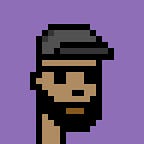Meet the Curation Board: Cooper Jamieson
Meet the Curation Board is a series that introduces the Art Blocks community to the board members and their backgrounds.
1. What is your background as it relates to art and design?
I come from a family of artists, and I’m kind of the odd one as I chose to study chemistry as well as art. In school, I focused on ceramics and painting. After receiving degrees in chemistry and art, I worked as an assistant to Robert Irwin and helped fabricate his large-scale and permanent installation untitled (Dawn to Dusk) at the Chinati Foundation in Marfa, Texas. This was an amazing experience to work first-hand with the San Diego light and space artist who is typically ‘available in response’ and creates installations based on the surroundings and the architecture of the gallery space. Untitled (Dawn to Dusk) took 17 years of work to realize, and I feel incredibly privileged to have been there at the end and assist as I could. Let’s just say I learned a lot about looking while working for him. After completing untitled (Dawn to Dusk), I accepted a position in art conservation at the Chinati Foundation.
Four years ago, I left art conservation to obtain a PhD in theoretical chemistry. At that time, I had this understanding that artists and scientists were asking the same questions, but just presenting their arguments differently; either in the form of an installation or as an academic paper. I really chose to study theoretical chemistry in order to learn the scientific method and how I could apply it to art.
2. What is your background as it relates to crypto?
I would say that I am really new to crypto. I was introduced to this world in 2014 by a good friend and was initially fascinated by crypto as a tool to restructure the current financial system and make it more equitable. But, I did not partake or really use these new technologies until January 2021, when I discovered how people were using these technologies to further digital art.
3. How would you describe your taste in art?
Some of my favorite works are purely about sight or the experience of seeing; artworks that cause you, as Lawrence Weschler says, “to perceive yourself perceiving … to kind of jumpstart yourself into an awareness of how simply miraculous seeing is.”1 Some examples of such works would be Donald Judd’s Untitled, 1976, Doug Wheeler’s Untitled, 2020, or any of Robert Irwin’s scrim works.
On a very different note, I am also drawn to playful paintings and ceramics by Laura Owens, Jeff Elrod, Paul Chan, or Magdalena Suarez-Frimkess. These works just light up a room. I do find myself returning to the rigid and structured works by Hanne Darboven and Blinky Palermo as well. And, lastly, I have been thinking a lot about Charlotte Posenenske’s work (as well as her rejection of the art market) and how this could translate to a generative form in the crypto space.
4. What got you interested in Art Blocks?
I was first drawn to Art Blocks solely from the quality of the artworks. But, as I learned more, I found the community to be so amazing, engaging, supportive, and forward-thinking. This community is a perfect mix of nice people and great art.
5. When you review an Art Blocks project for curation, what qualities are you looking for?
I really look for, first, diversity of outputs and, then, whether each output can hold its own. I want works that are engaging visually. It’s a truly special thing when the artist can create an algorithm that spits out one after one beautiful and unique works of art for more than 500 iterations.
6. What is your overall vision for the curated collection at Art Blocks?
I will push for a curated collection that is financially accessible, features emerging as well as established artists, and really pushes the conceptions of what generative art/content can be.
7. Is there anything you hope to see in future projects?
Besides just more amazing art, I want to see
1) collaborative projects where groups of artists each contribute maybe 200 or 500 bytes to a script — essentially correspondence chess.
2) interactive fiction and purely text-based works.
3) generative side-scrolling games.
